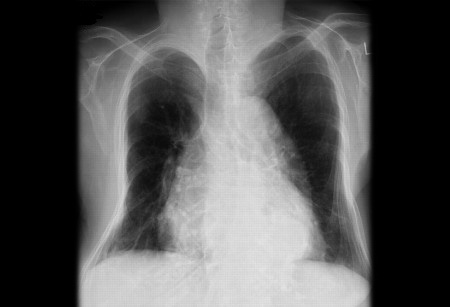全面的临床评估对诊断至关重要,因为骨折前该病无症状。根据危险因素史和筛查计划进行临床评估。既往低创伤脆性骨折史可提示疾病。无骨折时该病无症状,脆性骨折可能是该病的首要证据。实验室检查可排除骨质丢失的可逆继发性原因。
临床评估
病史的重要组成部分包括年龄、性别、种族、是否为绝经后女性、是否有腹部疾病、制动史和既往骨折史。
吸烟、饮酒、使用肝素、抗惊厥药、糖皮质激素和芳香化酶抑制剂(女性)或雄激素阻断治疗(男性)。
患者可能会主诉身高(尤其是脊柱后凸)、体重、饮食改变和疼痛。
评估骨折的风险并调查既往跌倒史。
体格检查
检查可能发现无症状骨折引起的低体质指数和脊柱后凸。
可通过测试患者视力和评估患者平衡能力、步态及下肢力量来评估跌倒和骨折的风险。
影像
通过DXA进行BMD测定为确定性检查,且在很多情况下,优选该方法进行诊断。使用DXA对存在危险因素的患者进行筛查可以对许多骨质疏松症做出诊断。然而,关于骨矿物质密度分析的合理使用存在争论。例如,在评估骨质疏松性骨折预防的研究中,英国国家卫生与临床优化研究所(NICE)指南提出,具有两种或以上骨折的独立危险因素或低BMD指标的75岁及以上女性,如果负责的医师认为DXA扫描临床不合适或不可行,则可不进行该项检查。[31]National Institute for Health and Care Excellence. Alendronate, etidronate, risedronate, raloxifene and strontium ranelate for the primary prevention of osteoporotic fragility fractures in postmenopausal women. January 2011. http://www.nice.org.uk/ (last accessed 27 September 2016).http://www.nice.org.uk/guidance/ta161[34]National Institute for Health and Care Excellence. Alendronate, etidronate, risedronate, raloxifene, strontium ranelate and teriparatide for the secondary prevention of osteoporotic fragility fractures in postmenopausal women. January 2011. http://www.nice.org.uk (last accessed 27 September 2016).http://www.nice.org.uk/guidance/ta161但是,人们普遍认为骨矿物质密度分析适用于脆性骨折(低创伤骨折)、雌激素或睾酮缺乏、身高降低、影像学显示骨质减少、或风湿性关节炎(无论是否接受皮质类固醇治疗)的患者以及口服皮质类固醇治疗的患者。[35]Adams J, Bishop N. DXA in adults and children. In: Rosen CJ, Compston JE, Lian JB, et al, eds. Primer on the metabolic bone diseases and disorders of mineral metabolism. 7th ed. Washington, DC: American Society for Bone and Mineral Research; 2008:152-158.
如果DXA不可用,可用定量超声(QUS)替代,但是DXA 的诊断标准不适用于QUS。[3]WHO Scientific Group on the Prevention and Management of Osteoporosis. Prevention and management of osteoporosis: report of a WHO scientific group. (WHO technical report series: 921.) Geneva, Switzerland: WHO; 2000.http://whqlibdoc.who.int/trs/WHO_TRS_921.pdfQUS是评估骨强度未知因素的方法,而并非用于评估骨矿物质密度。QUS可能是预测特定人群骨折的很好的方法,但不适用于预测个体骨折。此外,T值只适用于DXA检测而不适用于定量超声。
X线可能会显示骨量减少和/或骨折(如椎骨骨折)。[3]WHO Scientific Group on the Prevention and Management of Osteoporosis. Prevention and management of osteoporosis: report of a WHO scientific group. (WHO technical report series: 921.) Geneva, Switzerland: WHO; 2000.http://whqlibdoc.who.int/trs/WHO_TRS_921.pdf [Figure caption and citation for the preceding image starts]: 骨质疏松症患者的胸平片显示明显的骨性胸廓畸形和骨量减少。BMJ Case Reports 2009; doi:10.1136/bcr.07.2008.0359.Copyright ©BMJ publishing group 2010 [Citation ends].但不能用于疾病诊断。X线用于在偶然发现骨质减少后提示进行DXA测定。胸腰椎疼痛、身高降低和胸椎后凸的患者,都应考虑进行此检查。X线也可用于评估骨折发病率的临床研究。[36]Grados F, Fechtenbaum J, Flipon E, et al. Radiographic methods for evaluating osteoporotic vertebral fractures. Joint Bone Spine. 2009;76:241-247.http://www.ncbi.nlm.nih.gov/pubmed/19196531?tool=bestpractice.com
[Figure caption and citation for the preceding image starts]: 骨质疏松症患者的胸平片显示明显的骨性胸廓畸形和骨量减少。BMJ Case Reports 2009; doi:10.1136/bcr.07.2008.0359.Copyright ©BMJ publishing group 2010 [Citation ends].但不能用于疾病诊断。X线用于在偶然发现骨质减少后提示进行DXA测定。胸腰椎疼痛、身高降低和胸椎后凸的患者,都应考虑进行此检查。X线也可用于评估骨折发病率的临床研究。[36]Grados F, Fechtenbaum J, Flipon E, et al. Radiographic methods for evaluating osteoporotic vertebral fractures. Joint Bone Spine. 2009;76:241-247.http://www.ncbi.nlm.nih.gov/pubmed/19196531?tool=bestpractice.com
如果DXA不可用,可用定量CT测量骨小梁的骨密度。
实验室评估
骨吸收的生化标记物可与BMD联合使用,有效预测骨折风险,且通常可帮助决定是否开始治疗。[3]WHO Scientific Group on the Prevention and Management of Osteoporosis. Prevention and management of osteoporosis: report of a WHO scientific group. (WHO technical report series: 921.) Geneva, Switzerland: WHO; 2000.http://whqlibdoc.who.int/trs/WHO_TRS_921.pdf骨转换标志物可特定用于监测治疗疗效,而不是一种治疗方法。[37]Allende-Vigo MZ. The use of biochemical markers of bone turnover in osteoporosis. P R Health Sci J. 2007;26:91-95.http://www.ncbi.nlm.nih.gov/pubmed/17722420?tool=bestpractice.com[38]Vasikaran S, Eastell R, Bruyère O, et al. Markers of bone turnover for the prediction of fracture risk and monitoring of osteoporosis treatment: a need for international reference standards. Osteoporos Int. 2011;22:391-420.http://www.ncbi.nlm.nih.gov/pubmed/21184054?tool=bestpractice.com
诊断后进行实验室评估的目的是,排除根据临床病史和体格检查怀疑的基础疾病。[2]NIH Consensus Development Panel on Osteoporosis Prevention, Diagnosis, and Therapy. Osteoporosis prevention, diagnosis, and therapy. JAMA. 2001;285:785-795.http://www.ncbi.nlm.nih.gov/pubmed/11176917?tool=bestpractice.com所有患者的初始实验室检查应评估肾功能、钙、白蛋白、磷和维生素D水平。男性患者也应检测睾酮水平。
提示骨质疏松症潜在病因的结果包括:[3]WHO Scientific Group on the Prevention and Management of Osteoporosis. Prevention and management of osteoporosis: report of a WHO scientific group. (WHO technical report series: 921.) Geneva, Switzerland: WHO; 2000.http://whqlibdoc.who.int/trs/WHO_TRS_921.pdf
 [Figure caption and citation for the preceding image starts]: 骨质疏松症患者的胸平片显示明显的骨性胸廓畸形和骨量减少。BMJ Case Reports 2009; doi:10.1136/bcr.07.2008.0359.Copyright ©BMJ publishing group 2010 [Citation ends].但不能用于疾病诊断。X线用于在偶然发现骨质减少后提示进行DXA测定。胸腰椎疼痛、身高降低和胸椎后凸的患者,都应考虑进行此检查。X线也可用于评估骨折发病率的临床研究。[36]
[Figure caption and citation for the preceding image starts]: 骨质疏松症患者的胸平片显示明显的骨性胸廓畸形和骨量减少。BMJ Case Reports 2009; doi:10.1136/bcr.07.2008.0359.Copyright ©BMJ publishing group 2010 [Citation ends].但不能用于疾病诊断。X线用于在偶然发现骨质减少后提示进行DXA测定。胸腰椎疼痛、身高降低和胸椎后凸的患者,都应考虑进行此检查。X线也可用于评估骨折发病率的临床研究。[36]